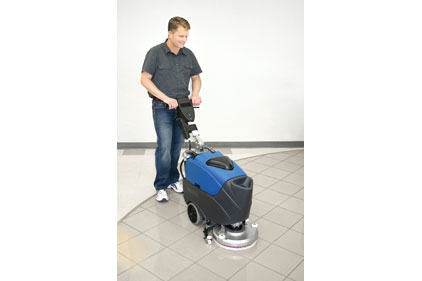However, there are ways to avoid common problems. Proper training is the most important preventive measure. Custodial workers, whether in-house or contracted, must be thoroughly trained on how to perform floor care tasks. The nonprofit Institute of Inspection, Cleaning, and Restoration, as well as ISSA, the worldwide cleaning association, offer “best practices” instructional programs on floor care at moderate costs. Local distributors can often provide instructional help and additional advice as well.
Even with proper training, glitches can occur. Following is a list of common floor care problems along with some guidelines to help solve or prevent them:
Floor finish (wax) adhering problems: Sometimes the finish does not properly adhere to the floor, especially with terrazzo flooring. One reason for this is climate conditions. When the weather is too hot, too cold or too humid, the finish may not dry properly, which can impact how well it adheres to the floor and result in safety hazards as well as a poor appearance. Perform major floor care tasks such as stripping and refinishing during moderate climate conditions. If climate is not the issue or to help prevent this problem from occurring, apply a sealer to the floor before applying the finish.
Uneven shine, soiling or streaks: Improper use of mops and buckets can cause a floor’s shine to appear uneven, soiled or streaky shortly after restoration. Mops and buckets used for cleaning should be kept separate from those used to apply finish. Some manufacturers provide “mop paks” that consist of the four separate mops necessary for a complete floor strip and refinish. As an added measure, if different types of finishes are applied to different floors, use a specific mop for each type of finish and floor. Different finishes may not work well together.
Incompatible products: Many chemical manufacturers formulate their floor care chemicals to work together as a system, so it is often best to select all the chemicals used for floor care tasks from the same manufacturer.
The wrong “green” product for the floor: Using a new environmentally preferable floor care finish without proper previous assessment is not a good idea. Chemical manufacturers have had some challenges making green equivalents of floor finishes. While there have been significant improvements, some green finishes work better on certain types of flooring than others. To be safe, test the product in a small area first.
Getting more specific
Sometimes managers are confronted with less common floor care problems, such as “powdering,” poor gloss and discolored gloss. Solutions to these problems may be more involved.
For instance, powdering is when a floor finish begins to flake or disintegrate, forming a powder on the floor surface.
Causes include:
• If the floor is new, the protective finish applied to the floor by the manufacturer was not removed. Many floors are delivered with a protective coating that must be removed before the finish is applied.
• The floor finish applied does not work well with the type of floor installed.
• A high-speed burnisher was used to polish a floor designed for conventional or low-speed buffing.
To eliminate powdering, first dust-mop the floor. If the powdering persists, it may be necessary to start fresh, by restripping or scrubbing the floor.
A related problem is poor gloss or shine. This often occurs when not enough finish was applied to the floor. Always apply at least three and up to six coats of finish for a high-gloss shine.
Another problem is when the gloss appears discolored. This often results when new cotton mops are used to apply the finish. New mops are sometimes treated with an oil that must be washed off in a neutral cleaner before the mop is used with a finish. Other causes of this problem are soiled mops/buckets, improper dilution of the stripper/cleaner, and/or not properly cleaning or stripping the floor before beginning work. Often the only remedy is to scrub or restrip the floor and start fresh.
The machine component
As you can imagine, even the best training and techniques can fall short if the equipment used to perform floor care is not up to the task. Some manufacturers make machines that last several years. When selecting a floor care machine, view it as an investment in the long-term upkeep, health, safety and appearance of your facility.
When it comes to conventional buffers, look for a 20-inch machine with a dual-speed motor. Twenty inches is wide enough to tackle many larger floor care tasks, and a dual-speed machine is essentially two machines in one: a slower speed (175 revolutions per minute – rpm) for stripping and a faster speed (320 rpm) for more effective buffing. Look for a machine with an all-metal handle housing, at least a three-year warranty, 1.5 horsepower for adequate performance, and a rotational molded engine housing. This protects the machine, protects floor surfaces, and helps absorb vibrations that can result in worker fatigue.
As for burnishers, which provide a “wet-look shine,” a 1,200 rpm to 2,000 rpm machine will perform well. A low-profile machine is preferable because it can get under workstations affixed to the floor. Also look for a safety trigger handle and a machine with balanced weight distribution. Some problems described earlier, such as uneven shine or streaks, can be caused by using a machine with improper weight distribution. If working with a janitorial distributor or buying directly from a manufacturer, select equipment that has “precision balanced” weight distribution and full pad contact.
Why bother?
The floor care problems addressed here all assume a finish has been applied to the floor. But many managers decide not to apply a finish to their floors, believing it is unnecessary and not cost-effective.
Finishes do far more than just make floors shiny and improve their appearance. They also help protect the floor from scratches and heel marks, lengthen the life span of the floor, make the floor easier to clean and maintain, and help prevent grout areas from becoming soiled and discolored. And using “high-traction” finishes can significantly enhance floor safety, always a top priority for facility managers.






